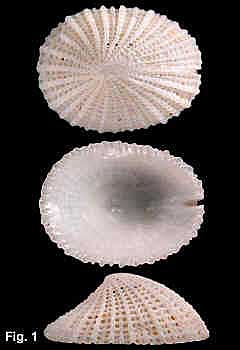|
|
|
|
|
Emarginula candida Adams, 1852 Description: Shell oval in outline, widest at centre. Apex backward pointing and recurved; position varies from slightly behind centre to posterior third. Anterior slope convex, posterior slope concave. Slit in anterior margin, a quarter of length of anterior slope, with bordering flanges. Selenizone a strong elevated, beaded ridge from slit to apex. Sculptured with 20-30 strong axial ribs with a smaller rib between each, crossed by concentric ribs of about same strength, producing a cancellate surface with beads at intersections. Margin crenulate internally. Colour white. Size: Up to 15 mm in length. Distribution: Endemic to Australia: Woolgoolga, NSW, to southern WA, including Tasmania. Habitat: Low tide down to 270 m, but usually collected as beach shells. Uncommon. Comparison: This species is distinguished by the elevated selenizone rib from apex to slit; in other NSW Emarginula species the selenizone is flat or concave. Synonymy: The NSW shell was named Emarginula hedleyi Thiele, 1915, but it does not differ significantly from shells throughout the rest of the range. Remarks: Over a range of specimens ratio of height to length varies from 0.36-0.54. The number of concentric ribs is also variable but most specimens have concentric rib spacing about the same as the major axials, giving a regular latticed effect with deep pits between ribs. Fig. 1 Broulee, NSW (DLB4970) |
